Page 3455 of 4179
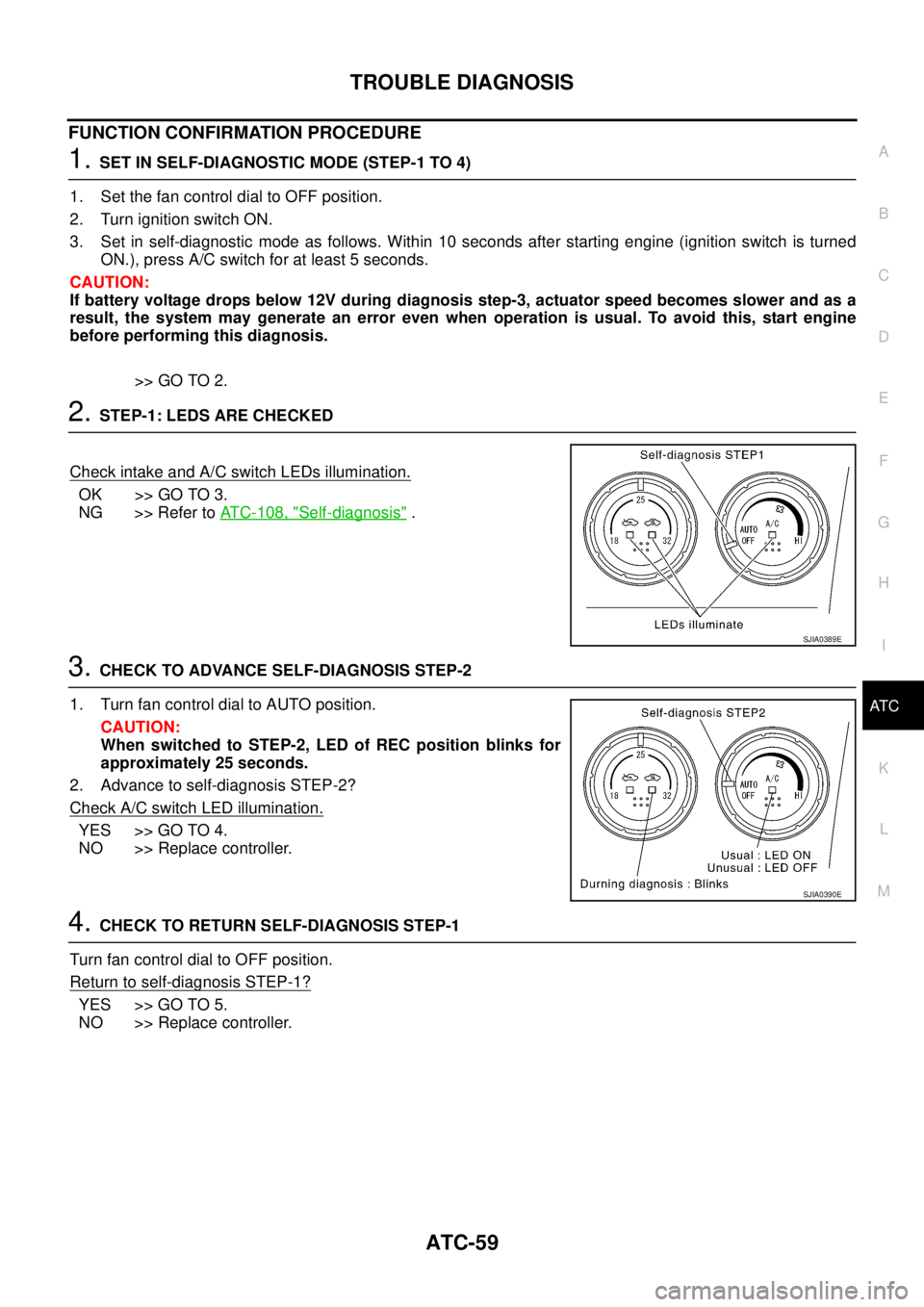
TROUBLE DIAGNOSIS
ATC-59
C
D
E
F
G
H
I
K
L
MA
B
AT C
FUNCTION CONFIRMATION PROCEDURE
1. SET IN SELF-DIAGNOSTIC MODE (STEP-1 TO 4)
1. Set the fan control dial to OFF position.
2. Turn ignition switch ON.
3. Set in self-diagnostic mode as follows. Within 10 seconds after starting engine (ignition switch is turned
ON.), press A/C switch for at least 5 seconds.
CAUTION:
If battery voltage drops below 12V during diagnosis step-3, actuator speed becomes slower and as a
result, the system may generate an error even when operation is usual. To avoid this, start engine
before performing this diagnosis.
>> GO TO 2.
2. STEP-1: LEDS ARE CHECKED
Check intake and A/C switch LEDs illumination.
OK >> GO TO 3.
NG >> Refer to ATC-108, "
Self-diagnosis" .
3. CHECK TO ADVANCE SELF-DIAGNOSIS STEP-2
1. Turn fan control dial to AUTO position.
CAUTION:
When switched to STEP-2, LED of REC position blinks for
approximately 25 seconds.
2. Advance to self-diagnosis STEP-2?
Check A/C switch LED illumination.
YES >> GO TO 4.
NO >> Replace controller.
4. CHECK TO RETURN SELF-DIAGNOSIS STEP-1
Turn fan control dial to OFF position.
Return to self
-diagnosis STEP-1?
YES >> GO TO 5.
NO >> Replace controller.
SJIA0389E
SJIA0390E
Page 3459 of 4179
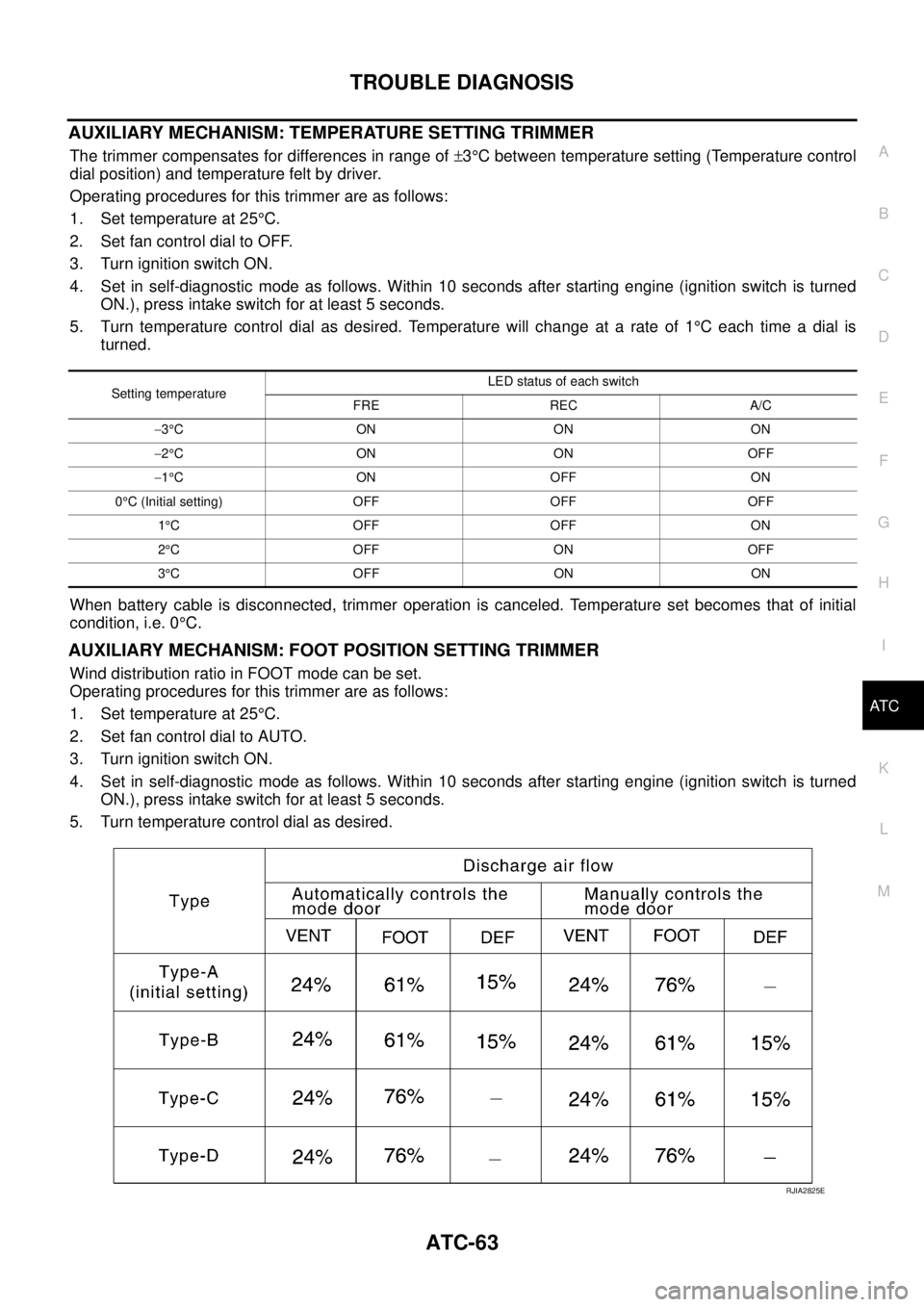
TROUBLE DIAGNOSIS
ATC-63
C
D
E
F
G
H
I
K
L
MA
B
AT C
AUXILIARY MECHANISM: TEMPERATURE SETTING TRIMMER
The trimmer compensates for differences in range of ±3°C between temperature setting (Temperature control
dial position) and temperature felt by driver.
Operating procedures for this trimmer are as follows:
1. Set temperature at 25°C.
2. Set fan control dial to OFF.
3. Turn ignition switch ON.
4. Set in self-diagnostic mode as follows. Within 10 seconds after starting engine (ignition switch is turned
ON.), press intake switch for at least 5 seconds.
5. Turn temperature control dial as desired. Temperature will change at a rate of 1°C each time a dial is
turned.
When battery cable is disconnected, trimmer operation is canceled. Temperature set becomes that of initial
condition, i.e. 0°C.
AUXILIARY MECHANISM: FOOT POSITION SETTING TRIMMER
Wind distribution ratio in FOOT mode can be set.
Operating procedures for this trimmer are as follows:
1. Set temperature at 25°C.
2. Set fan control dial to AUTO.
3. Turn ignition switch ON.
4. Set in self-diagnostic mode as follows. Within 10 seconds after starting engine (ignition switch is turned
ON.), press intake switch for at least 5 seconds.
5. Turn temperature control dial as desired.
Setting temperatureLED status of each switch
FRE REC A/C
−3°CON ON ON
−2°CON ON OFF
−1°CON OFF ON
0°C (Initial setting) OFF OFF OFF
1°COFFOFF ON
2°COFF ON OFF
3°C OFF ON ON
RJIA2825E
Page 3460 of 4179

ATC-64
TROUBLE DIAGNOSIS
AUXILIARY MECHANISM: INLET PORT MEMORY FUNCTION
When ignition switch is turned from OFF to ON, inlet port can be set to AUTO or manual.
Operating procedures for this trimmer are as follows:
1. Set fan control dial to 1st-25th speed.
2. Turn ignition switch ON.
3. Set in self-diagnostic mode as follows. Within 10 seconds after starting engine (ignition switch is turned
ON.), press intake switch for at least 5 seconds.
4. Press intake switch as desired.
Ty p eLED status of each switch
FRE REC A/C
Type-A (initial setting) OFF OFF ON
Ty p e - B O F F O N OF F
Ty p e - C O F F O N O N
Ty p e - D ON O F F OF F
LED status
of FRE
positionLED status
of REC posi-
tionSetting status
Setting changeover method
FRE REC
OFF OFF AUTO control AUTO control
Intake SW: ON OFF ON AUTO control (Initial setting)Manual REC status is memorized.
(Initial setting)
ON OFF Manual FRE status is memorized. AUTO control
ON ON Manual FRE status is memorized. Manual REC status is memorized.
Page 3461 of 4179
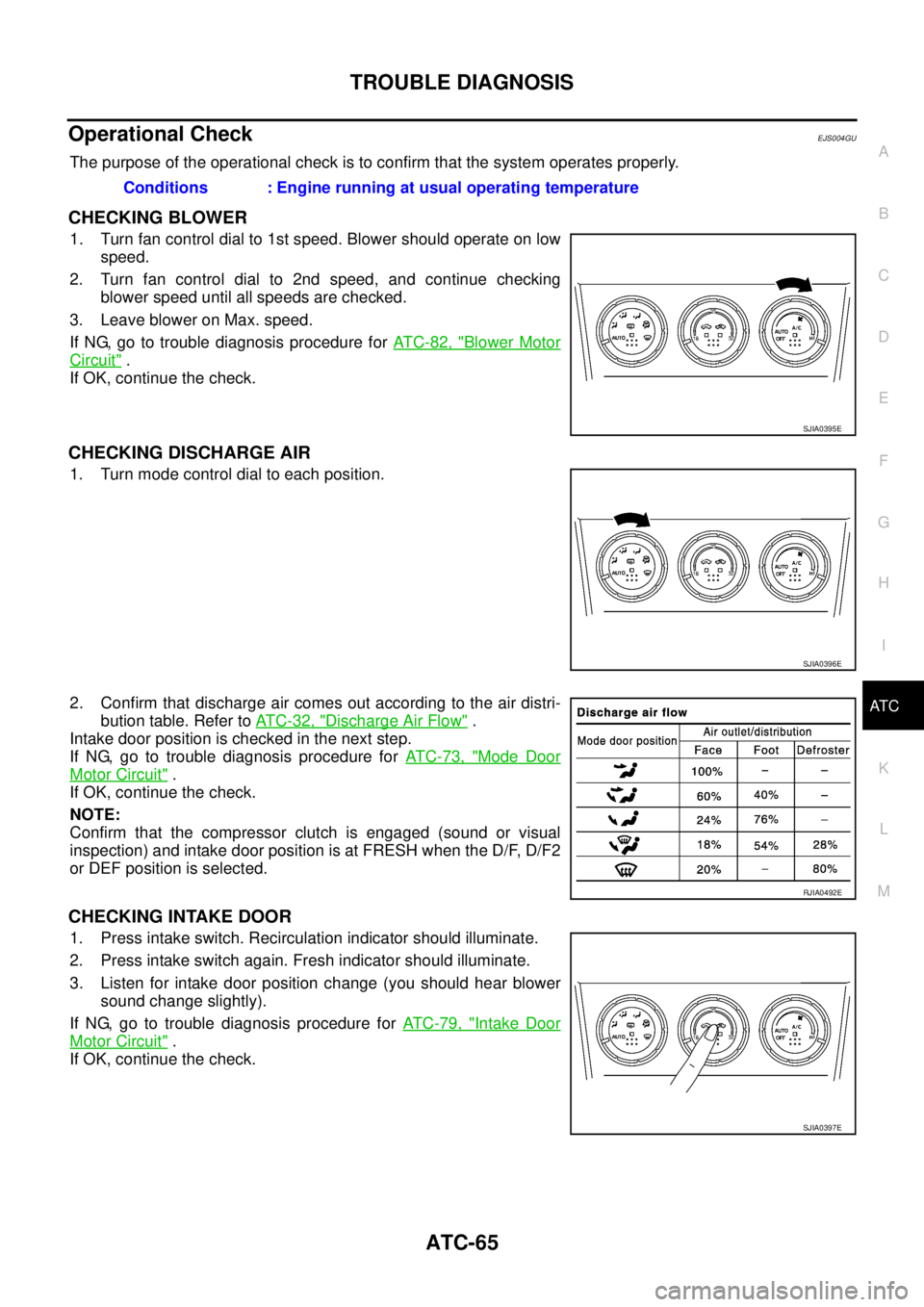
TROUBLE DIAGNOSIS
ATC-65
C
D
E
F
G
H
I
K
L
MA
B
AT C
Operational CheckEJS004GU
The purpose of the operational check is to confirm that the system operates properly.
CHECKING BLOWER
1. Turn fan control dial to 1st speed. Blower should operate on low
speed.
2. Turn fan control dial to 2nd speed, and continue checking
blower speed until all speeds are checked.
3. Leave blower on Max. speed.
If NG, go to trouble diagnosis procedure for AT C - 8 2 , "
Blower Motor
Circuit" .
If OK, continue the check.
CHECKING DISCHARGE AIR
1. Turn mode control dial to each position.
2. Confirm that discharge air comes out according to the air distri-
bution table. Refer to AT C - 3 2 , "
Discharge Air Flow" .
Intake door position is checked in the next step.
If NG, go to trouble diagnosis procedure for AT C - 7 3 , "
Mode Door
Motor Circuit" .
If OK, continue the check.
NOTE:
Confirm that the compressor clutch is engaged (sound or visual
inspection) and intake door position is at FRESH when the D/F, D/F2
or DEF position is selected.
CHECKING INTAKE DOOR
1. Press intake switch. Recirculation indicator should illuminate.
2. Press intake switch again. Fresh indicator should illuminate.
3. Listen for intake door position change (you should hear blower
sound change slightly).
If NG, go to trouble diagnosis procedure for AT C - 7 9 , "
Intake Door
Motor Circuit" .
If OK, continue the check.Conditions : Engine running at usual operating temperature
SJIA0395E
SJIA0396E
RJIA0492E
SJIA0397E
Page 3479 of 4179
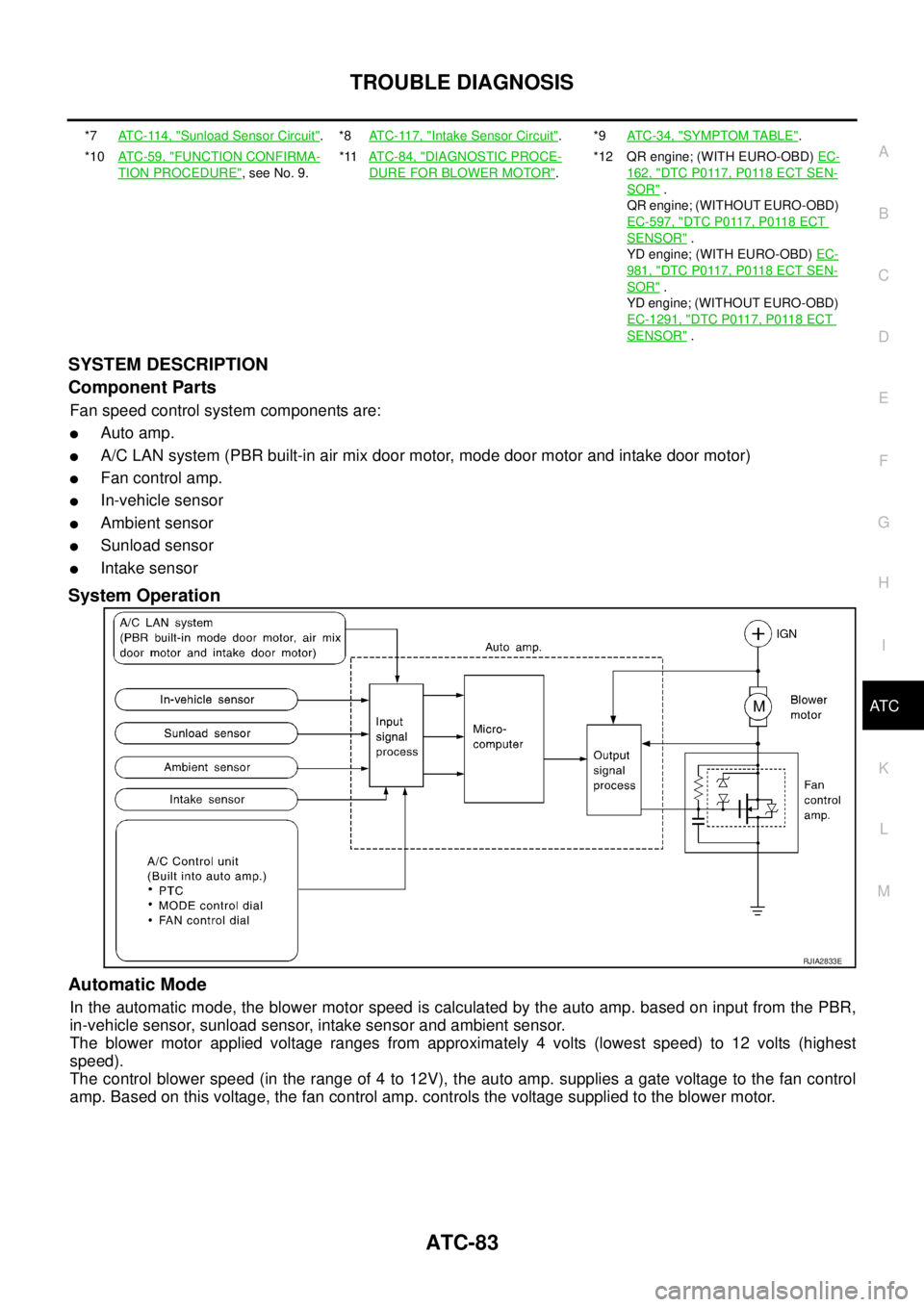
TROUBLE DIAGNOSIS
ATC-83
C
D
E
F
G
H
I
K
L
MA
B
AT C
SYSTEM DESCRIPTION
Component Parts
Fan speed control system components are:
�Auto amp.
�A/C LAN system (PBR built-in air mix door motor, mode door motor and intake door motor)
�Fan control amp.
�In-vehicle sensor
�Ambient sensor
�Sunload sensor
�Intake sensor
System Operation
Automatic Mode
In the automatic mode, the blower motor speed is calculated by the auto amp. based on input from the PBR,
in-vehicle sensor, sunload sensor, intake sensor and ambient sensor.
The blower motor applied voltage ranges from approximately 4 volts (lowest speed) to 12 volts (highest
speed).
The control blower speed (in the range of 4 to 12V), the auto amp. supplies a gate voltage to the fan control
amp. Based on this voltage, the fan control amp. controls the voltage supplied to the blower motor.
*7AT C - 11 4 , "Sunload Sensor Circuit".*8ATC-117, "Intake Sensor Circuit".*9AT C - 3 4 , "SYMPTOM TABLE".
*10AT C - 5 9 , "
FUNCTION CONFIRMA-
TION PROCEDURE", see No. 9.*11ATC-84, "
DIAGNOSTIC PROCE-
DURE FOR BLOWER MOTOR".*12 QR engine; (WITH EURO-OBD) EC-162, "DTC P0117, P0118 ECT SEN-
SOR" .
QR engine; (WITHOUT EURO-OBD)
EC-597, "
DTC P0117, P0118 ECT
SENSOR" .
YD engine; (WITH EURO-OBD) EC-
981, "DTC P0117, P0118 ECT SEN-
SOR" .
YD engine; (WITHOUT EURO-OBD)
EC-1291, "
DTC P0117, P0118 ECT
SENSOR" .
RJIA2833E
Page 3480 of 4179
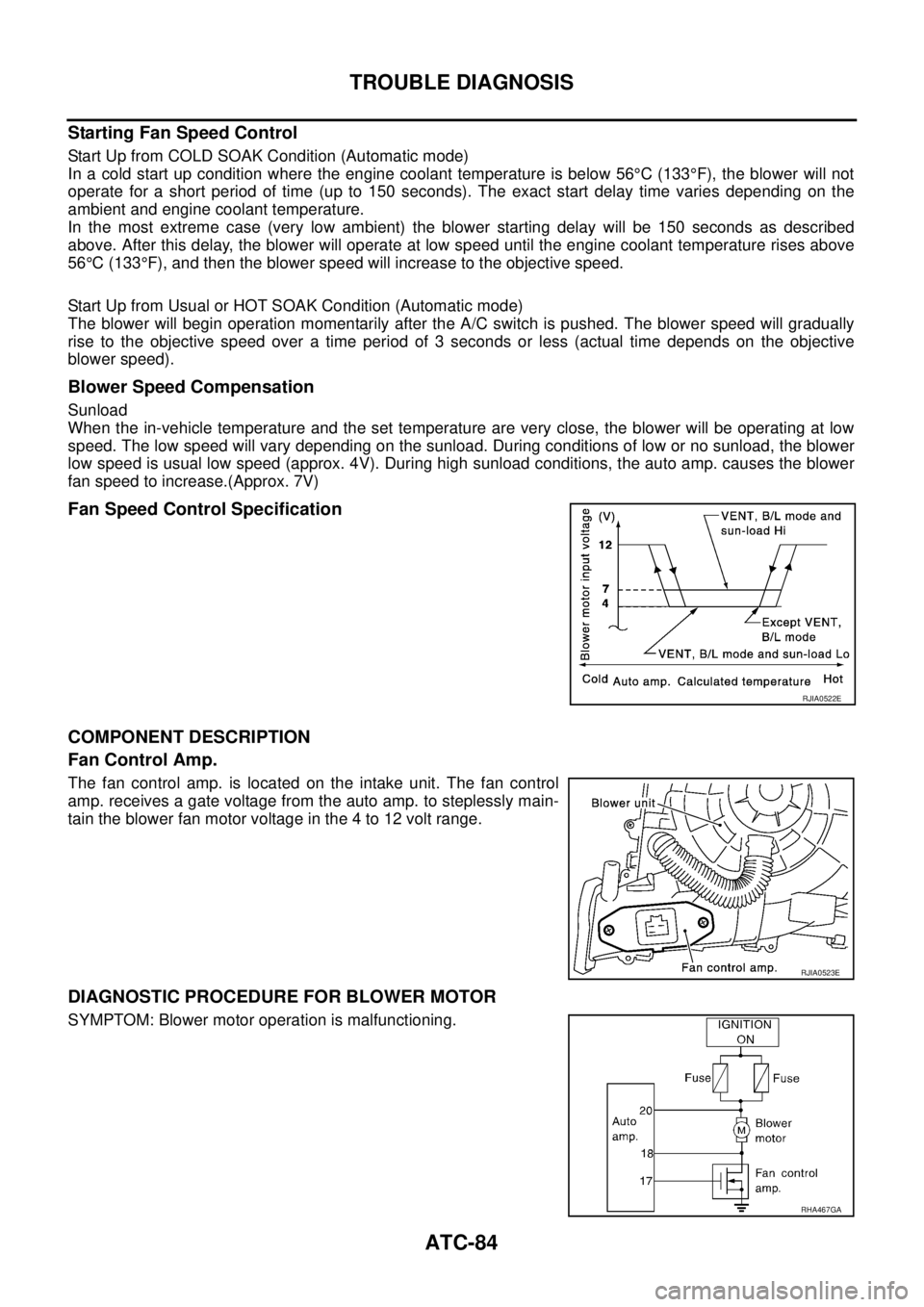
ATC-84
TROUBLE DIAGNOSIS
Starting Fan Speed Control
Start Up from COLD SOAK Condition (Automatic mode)
In a cold start up condition where the engine coolant temperature is below 56°C (133°F), the blower will not
operate for a short period of time (up to 150 seconds). The exact start delay time varies depending on the
ambient and engine coolant temperature.
In the most extreme case (very low ambient) the blower starting delay will be 150 seconds as described
above. After this delay, the blower will operate at low speed until the engine coolant temperature rises above
56°C (133°F), and then the blower speed will increase to the objective speed.
Start Up from Usual or HOT SOAK Condition (Automatic mode)
The blower will begin operation momentarily after the A/C switch is pushed. The blower speed will gradually
rise to the objective speed over a time period of 3 seconds or less (actual time depends on the objective
blower speed).
Blower Speed Compensation
Sunload
When the in-vehicle temperature and the set temperature are very close, the blower will be operating at low
speed. The low speed will vary depending on the sunload. During conditions of low or no sunload, the blower
low speed is usual low speed (approx. 4V). During high sunload conditions, the auto amp. causes the blower
fan speed to increase.(Approx. 7V)
Fan Speed Control Specification
COMPONENT DESCRIPTION
Fan Control Amp.
The fan control amp. is located on the intake unit. The fan control
amp. receives a gate voltage from the auto amp. to steplessly main-
tain the blower fan motor voltage in the 4 to 12 volt range.
DIAGNOSTIC PROCEDURE FOR BLOWER MOTOR
SYMPTOM: Blower motor operation is malfunctioning.
RJIA0522E
RJIA0523E
RHA467GA
Page 3485 of 4179
TROUBLE DIAGNOSIS
ATC-89
C
D
E
F
G
H
I
K
L
MA
B
AT C
SYSTEM DESCRIPTION
Auto amp. controls compressor operation by ambient temperature, intake air temperature (with diesel engine)
and signal from ECM.
Low Temperature Protection Control (With Gasoline Engine)
Auto amp. will turn compressor ON or OFF as determined by a sig-
nal detected by ambient sensor.
When ambient temperatures are higher than −2°C (28°F), compres-
sor turns ON. Compressor turns OFF when ambient temperatures
are lower than −5°C (23°F).
Evaporator Freeze Protection Control (With Diesel Engine)
Auto amp. will turn compressor ON or OFF as determined by a sig-
nal detected by intake sensor.
When intake air temperatures are higher than 4°C (39°F), compres-
sor turns ON. Compressor turns OFF when intake temperatures are
lower than 2.5°C (37°F).
DIAGNOSTIC PROCEDURE FOR MAGNET CLUTCH
SYMPTOM: Magnet clutch does not engage when A/C switch is ON.
RHA094GB
RHA094GD
RJIA2835E
Page 3486 of 4179
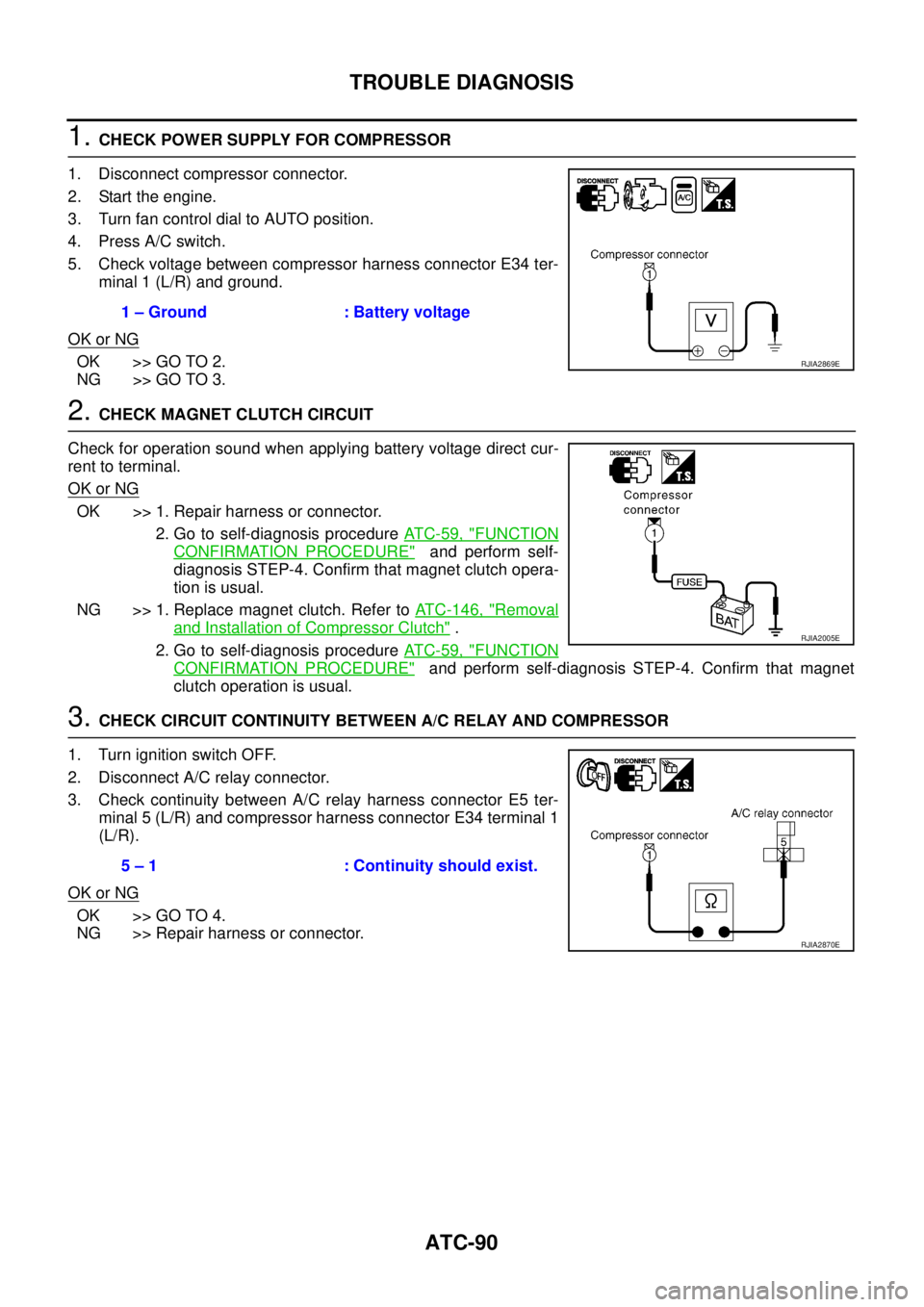
ATC-90
TROUBLE DIAGNOSIS
1. CHECK POWER SUPPLY FOR COMPRESSOR
1. Disconnect compressor connector.
2. Start the engine.
3. Turn fan control dial to AUTO position.
4. Press A/C switch.
5. Check voltage between compressor harness connector E34 ter-
minal 1 (L/R) and ground.
OK or NG
OK >> GO TO 2.
NG >> GO TO 3.
2. CHECK MAGNET CLUTCH CIRCUIT
Check for operation sound when applying battery voltage direct cur-
rent to terminal.
OK or NG
OK >> 1. Repair harness or connector.
2. Go to self-diagnosis procedure AT C - 5 9 , "
FUNCTION
CONFIRMATION PROCEDURE" and perform self-
diagnosis STEP-4. Confirm that magnet clutch opera-
tion is usual.
NG >> 1. Replace magnet clutch. Refer to ATC-146, "
Removal
and Installation of Compressor Clutch" .
2. Go to self-diagnosis procedure AT C - 5 9 , "
FUNCTION
CONFIRMATION PROCEDURE" and perform self-diagnosis STEP-4. Confirm that magnet
clutch operation is usual.
3. CHECK CIRCUIT CONTINUITY BETWEEN A/C RELAY AND COMPRESSOR
1. Turn ignition switch OFF.
2. Disconnect A/C relay connector.
3. Check continuity between A/C relay harness connector E5 ter-
minal 5 (L/R) and compressor harness connector E34 terminal 1
(L/R).
OK or NG
OK >> GO TO 4.
NG >> Repair harness or connector.1 – Ground : Battery voltage
RJIA2869E
RJIA2005E
5 – 1 : Continuity should exist.
RJIA2870E